In my previous post I described what turned out to be 6 months of waiting for total hip replacement surgery, including being scheduled once, then cancelled, then scheduled again, due to healthcare system responses and adaptations to the coronavirus pandemic. During this period of time I had a few discussions with a good friend who, besides being perceptive, has close secondhand experience with joint replacement surgery. One time, not too long before the surgery was rescheduled, we talked about a pain tunnel and being able, at some point, to see the end of it coming into view. My pain was not actually very severe, but I had been living with it off-and-on, mostly on, for a few years – so I appreciated the mental visualization. Indeed, I’d had very few days that were completely pain-free. Certainly I was hoping that, when I thought I was starting to see light, it wasn’t the proverbial train coming the other way!
I paused my story in the previous post at the evening before the surgery. I had done as much as I could to keep my body and spirits strong and to prepare various aids that I would need in the days immediately following the surgery. I was acutely aware that the surgery was planned to be an outpatient procedure, so I’d hopefully be returning home late in the afternoon.
I had received a calendar, or timeline, describing several preparations I needed to do the evening before. I was to shower and wash my hair, but use no deodorant or lotions. After putting on a clean nightgown I was to wait one hour and then use some special wipes to wipe my body, a section at a time in a specific sequence essentially from top to bottom. Then I was supposed to put on a new clean nightgown, not the same one I’d worn for an hour. Of course, my towels and sheets had been freshly laundered, and my entire bathroom and sleeping area had recently been thoroughly cleaned.
My last opportunity to eat solid food was 8 hours prior to my scheduled arrival time at the hospital. That magic time happened to be 2am, so I had a small snack around 10pm. There was a special routine for brushing my teeth. I allowed for 8 1/2 hours in bed, and I actually slept quite well, avoiding a pre-big-event adrenaline rush.
I had been provided with a special pre-surgery drink consisting of complex carbs, to drink in the morning. I was supposed to drink it within a 15-minute period, 2 hours before my arrival time. I finished it at 8am on the dot. Then there was another special tooth-brushing, and no more eating or drinking. Of course I needed to dress in clean clothes. I checked and re-checked the small bag of items I would take with me, and finally it was time to leave.
When I arrived at the hospital my partner and I went to the surgery admissions area and went through that process. He provided his contact information to the hospital staff, I gave him the items I wouldn’t need any longer, and he left. I was shown to a gurney in a curtained-off waiting room. Shortly I was brought a hospital gown, hairnet, non-skid sock slippers, a belongings bag with my name and medical record number, and some more special wipes, even more than I had used the evening before. Once I was settled on the gurney in my hospital gown some special covers were placed over me and I was bathed in warm air.
Several people came in and out, taking vitals and asking questions. I confirmed multiple times that I was having total hip replacement surgery on my right hip. My surgeon came in, confirmed my procedure once again, and initialed my right hip. My anesthesiologist came in and we talked about how he was planning to sedate me (spinal plus a light general, the latter referred to today as sedation). I had brought a printed copy of an anesthesiology joke that I’d recently run across on-line. He had the good humor to accept the paper and put it away in a pocket.
At some point I had an opportunity to pee, and there was some waiting. An IV was started in the back of my right hand. I had brought a small MP3 player with me, and I started playing some relaxing music into my earbuds. The anesthesiologist came back in, I think, and had me sit up at the side of the bed while he pre-numbed me and gave me the spinal.
Suddenly I was being rolled away to the operating room. Once it’s time, it’s time right now. I’d removed my glasses but I could vaguely see a wall-mounted clock that read 11:50. In the OR I was transferred to an operating table, positioned on my left side – to present my right hip upward – and propped up from behind, with my right hand (with IV) on another support structure.
After that I apparently was sedated, per the plan. I knew what was supposed to happen during the surgery: the screws from the original repair would be removed, prior to all of the usual steps for a total hip replacement. I did become slightly aware at some point, and I recall hearing some noises that sounded like tapping or hammering. I surmised that the implant stem was being placed into my femur, and then I became unaware again.
For reference, here is an article that describes the surgical procedure. And this is what a hip implant looks like in an x-ray. It’s not mine, but I presume it’s similar.
After a while I woke up in the recovery area, once again lying on my back on a gurney under some comfortable covers. I suppose there was some more waiting, but I don’t remember much. My surgeon came in and told me that the surgery had gone well. I asked if the surface of the head of my femur had degraded further since my October x-ray, and she said it had. My partner appeared, smiling encouragingly. Somehow I got dressed and was coached by a physical therapist on how to get out of bed and stand up to use a walker to walk. I must have taken at least a few steps. I was still groggy, and undoubtedly had pain medication in my system. My partner was then sent off to the pharmacy to pick up some medications and bring the car to the walk-in surgery entrance, where we had entered several hours prior. I got my discharge instructions, got into a wheelchair, and was taken downstairs to my waiting vehicle, where I posed for a quick picture. I had deliberately selected everything I wore that day – including the bandana I was using as a face covering, which said “Go outside and play!” I was smiling behind the bandana.
At home I used the walker to go into the house and walk to the couch, where I had pre-placed pillows to elevate my leg. I had a snack, began taking some of the medications, and rested. I probably dozed off, since my sleep app data indicates I didn’t actually get into bed until after 11pm. I slept fitfully. I spent the entire next day, Day 1, on the couch, mostly dozing between having small meals, drinks, meds, and ice packs brought to me.
On Day 2 I had a Home Health Care physical therapy (PT) visit and was given a few exercises to begin, all of which I could do while reclined on the couch. I was diligent about taking the pain meds I’d been prescribed, as the discharge instructions strongly recommended staying ahead of pain.
On Day 4 I managed to sit up for an hour or so in a well-cushioned chair to attend a Zoom session (I didn’t need to do anything other than listen). The next day, Day 5, I attended another Zoom session in which I presented several photos to a photography interest group. I was already beginning to return to normal!
Earlier on Day 5 I’d had a second PT session at home. In addition to progressing my exercises, the therapist changed the dressing over my incision. I had been avoiding even touching the dressing, so I did not realize until then just how long my incision was. The therapist measured it, and it was 7 inches long! Here are a few pictures of the incision as it healed: on Day 5, Day 17, and Day 28. It had been closed with resorbable sutures and surgical glue, so there was nothing that needed to be removed. But I did have some “hanging chads” of glue around the end of the second week.
When I saw how long my incision was, I was pretty amazed that I didn’t experience more pain, and I could better understand the moderate pain I did experience. My primary pain medication was Percocet, which consists of the narcotic oxycodone plus acetaminophen. I was to take up to 2 tablets every 4 hours, as needed. I had decided in advance that I would take as little as possible, while still adequately controlling my pain. I just didn’t want to take a narcotic any more than was truly necessary. I ended up taking only 9 tablets total, the last at the end of Day 4. After that, on a few occasions I took an acetaminophen tablet in the evening, since I’d found that I was uncomfortable in bed.
But the most uncomfortable part of those early days was sitting on a toilet seat, since there was a weird kind of pressure on the incision, bulging it slightly outward. I quickly learned that, if I pressed my right hand against something nearby, like a cabinet or doorjamb, I could unweight my hip enough to be more comfortable.
Another uncomfortable aspect of the early days was a common side effect of narcotic medications: constipation. I had been given two meds to deal with that. In addition I was drinking MiraLax in a glass of water at least once a day, eating dried apricots, eating cherries, eating yoghurt, and drinking apple juice. Thankfully, once I got off the narcotics this situation resolved itself.
Yet another side effect of narcotic medications is lightheadedness, for some people. I had two brief, minor episodes, both upon standing up. The solution in both cases was simple: head for the nearest chair and sit down for a few minutes.
A second accomplishment of the Day 5 PT session was that I was ok’d to walk outdoors. I had a strong memory of walking outdoors on Day 4 after my repair surgery, and I remembered how wonderful it was to be in my happy place. This time I only walked out to the sidewalk and then to the far side of the yard, before returning.
A complication I had not anticipated was some trouble sleeping. A couple of nights I’ve had what I consider to be (mild) insomnia: I’d get into bed at, say, 11pm, go through my usual evening reading routine, and still be wide awake. One night I was restless for an hour and then simply sat back up, turned on a light, and read for another hour. When I discussed this with my physical therapist, she told me that insomnia is a not-uncommon side effect of orthopedic surgery. So I have made a point to be kind to myself about this, and I am generally sleeping better as my body becomes more comfortable trying to sleep in my usual positions.
One more minor side effect of the surgery is swelling and bruising in the foot and leg on my surgical (right) side, and this was discussed in my discharge paperwork. I had swelling in my foot and ankle for a couple of weeks. One day I tried wearing a compression stocking, but that was too onerous to get on and off, even with my partner’s help, so I focused on elevation. I found it perversely interesting to pee away some of the retained water in the morning, only to accumulate it again throughout the day.
There was significant swelling around the surgical site. I still ice it every day or two but, per the discharge papers, that may persist for a few months before going away completely.
During my Day 10 PT session, as I was trying out a new exercise for my physical therapist, she noticed that the back of my right calf was bruised. This is another side effect that I’d read about, but not noticed – it’s not easy to see unless you check while reclining on a couch or easy chair! There was no discomfort, so I hadn’t thought to check.
At each semi-weekly PT session I got more, and more challenging, exercises. The first exercises were mostly isometric, plus one to encourage blood circulation in my legs and feet (and discourage blood clots). Later I progressed to some strengthening exercises similar to those I’d been doing prior to surgery. Of course, I could only do mini versions at first. The surgery had involved cutting several muscles, including the gluteus medius, which is used for adduction (moving the leg out to the side) as well as stability for the entire hip during walking. Not surprisingly, many of the strengthening exercises target the various gluteus muscles.
Another mechanical area is related to range of motion, particularly bending the hip joint, because I had been impaired for months, if not years, leading up to the surgery. Strengthening and stretching the iliopsoas muscle, the main hip flexor, will be important in restoring a normal range of motion and walking gait.
On Day 19 I was discharged from home-based PT to outpatient PT. By then I was using my cane indoors, though still using the walker outdoors. The therapist who did my discharge suggested I consider using hiking poles for my outdoor walks, instead of the cane. I waited a couple of days, just to make sure I felt ready, and then made the transition. Here I’m returning home at the end of one of my walks on Day 23.
As I write this post I’m on Day 28 of my recovery. My incision is largely healed (see the photo above); the next step to encourage further healing is scar massage. Meanwhile my bone is busy attaching itself to the implanted parts, and this bone fixation should take 6-8 weeks. Muscle and other soft tissue repair will take a bit longer, 10-12 weeks. By then I will have already begun to return to longer walking sessions and even short hikes. I’m really looking forward to that! – and hope that shelter-in-place orders for my age group still support outdoor exercise. Currently I take 2 walks per day and am walking all the way around my small block, around 0.3 mile, on each walk.
When my hip was repaired I told virtually everyone who treated me that I wanted to be capable of doing another (power walking) marathon – and I did do one two years later. This time I have told several people who treated me that, almost exactly a year ago, I summited Mt Kilimanjaro, and I’d like to be capable of doing it again – even though I’ll more likely go somewhere I haven’t been yet, just to have a different adventure.
I’m looking forward to continued recovery and plan to write occasional updates along the way.


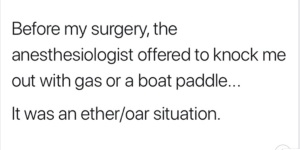
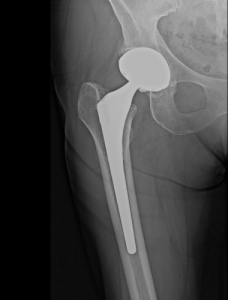
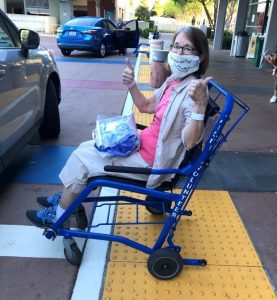

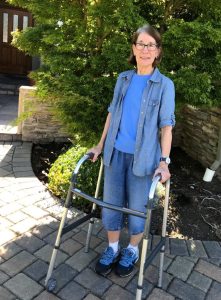
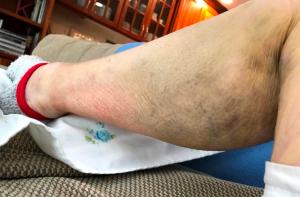
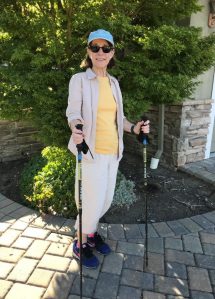
Pingback: Waiting Game, Training, and a False Alarm | trailhiker
Fantastic commentary of your process. What an inspiration you are to anyone wanting to go through this tunnel
Everyone’s journey is unique but, if I can add any insight for someone else facing the tunnel, it is more than worthwhile. Thank you for inspiring me to write and share my story.